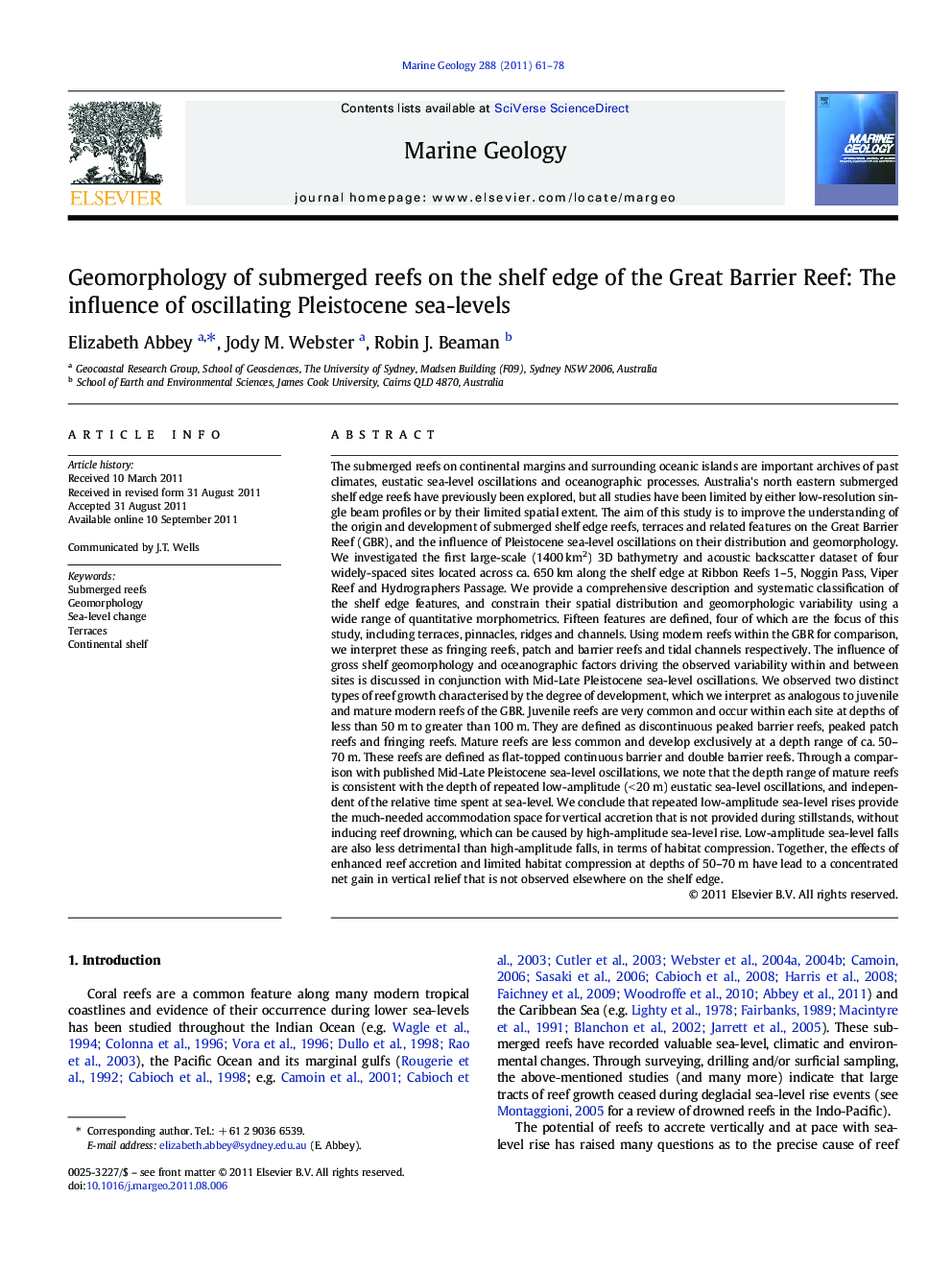| کد مقاله | کد نشریه | سال انتشار | مقاله انگلیسی | نسخه تمام متن |
|---|---|---|---|---|
| 4718700 | 1639132 | 2011 | 18 صفحه PDF | دانلود رایگان |

The submerged reefs on continental margins and surrounding oceanic islands are important archives of past climates, eustatic sea-level oscillations and oceanographic processes. Australia's north eastern submerged shelf edge reefs have previously been explored, but all studies have been limited by either low-resolution single beam profiles or by their limited spatial extent. The aim of this study is to improve the understanding of the origin and development of submerged shelf edge reefs, terraces and related features on the Great Barrier Reef (GBR), and the influence of Pleistocene sea-level oscillations on their distribution and geomorphology. We investigated the first large-scale (1400 km2) 3D bathymetry and acoustic backscatter dataset of four widely-spaced sites located across ca. 650 km along the shelf edge at Ribbon Reefs 1–5, Noggin Pass, Viper Reef and Hydrographers Passage. We provide a comprehensive description and systematic classification of the shelf edge features, and constrain their spatial distribution and geomorphologic variability using a wide range of quantitative morphometrics. Fifteen features are defined, four of which are the focus of this study, including terraces, pinnacles, ridges and channels. Using modern reefs within the GBR for comparison, we interpret these as fringing reefs, patch and barrier reefs and tidal channels respectively. The influence of gross shelf geomorphology and oceanographic factors driving the observed variability within and between sites is discussed in conjunction with Mid-Late Pleistocene sea-level oscillations. We observed two distinct types of reef growth characterised by the degree of development, which we interpret as analogous to juvenile and mature modern reefs of the GBR. Juvenile reefs are very common and occur within each site at depths of less than 50 m to greater than 100 m. They are defined as discontinuous peaked barrier reefs, peaked patch reefs and fringing reefs. Mature reefs are less common and develop exclusively at a depth range of ca. 50–70 m. These reefs are defined as flat-topped continuous barrier and double barrier reefs. Through a comparison with published Mid-Late Pleistocene sea-level oscillations, we note that the depth range of mature reefs is consistent with the depth of repeated low-amplitude (< 20 m) eustatic sea-level oscillations, and independent of the relative time spent at sea-level. We conclude that repeated low-amplitude sea-level rises provide the much-needed accommodation space for vertical accretion that is not provided during stillstands, without inducing reef drowning, which can be caused by high-amplitude sea-level rise. Low-amplitude sea-level falls are also less detrimental than high-amplitude falls, in terms of habitat compression. Together, the effects of enhanced reef accretion and limited habitat compression at depths of 50–70 m have lead to a concentrated net gain in vertical relief that is not observed elsewhere on the shelf edge.
► A high-res multibeam dataset from the NE Australian shelf edge was investigated.
► Quantitative morphometrics were used to characterise terraces, reefs and pinnacles.
► Submerged reefs range in development from juvenile to mature.
► The depth range of reefs was compared to Pleistocene sea-level oscillations.
► Mature reefs occur within a depth range of low-amplitude sea-level oscillations.
Journal: Marine Geology - Volume 288, Issues 1–4, 1 October 2011, Pages 61–78